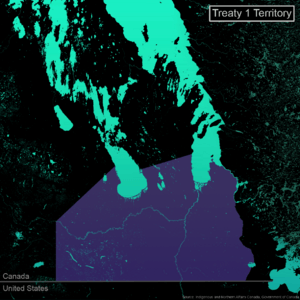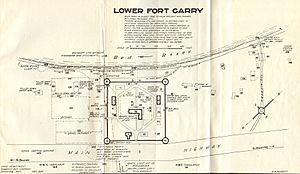Treaty 1 facts for kids
Treaty 1 (also known as the "Stone Fort Treaty") is an agreement established on August 3, 1871, between the Imperial Crown of Great Britain and Ireland and the Anishinabe and Swampy Cree nations. The first of a series of treaties called the Numbered Treaties that occurred between 1871–1921, this accord has been held to be essentially about peace and friendship. However, the eight days of treaty-making ended with the indigenous groups agreeing to "cede, release, surrender and yield up to Her Majesty the Queen and successors forever all the lands" in southern Manitoba to the Crown, in exchange for an annual annuity and material goods such as clothing and agricultural supplies.
Within a year of the agreement, however, the indigenous communities approached the Canadian government declaring that a number of the items promised, which would become known as the “Outside Promises”, within the treaty had not been handed over to them yet, although subjects of the Crown continued to settle the land-based upon the agreed-upon Treaty. On April 30, 1875, a council of the federal government passed an order stating that it must be ensured that all of the Outside Promises were to be fulfilled and considered a part of the main agreements within Treaty 1. However, due to the different intentions and understandings of the Canadian officials and the indigenous communities at the time of its creation, this treaty continues to be considered controversial well into the 21st century.
Contents
History
Also known as the Stone Fort Treaty, Treaty 1 would be the first treaty signed since the 1867 formation of the modern Canadian government and one year after the Province of Manitoba was formed as a part of the Canadian Confederation.
Goals
The treaty was established between Canadian officials and the local indigenous communities as both groups desired the security of land and resources. The Anishinabe and Swampy Cree Nations sought to maintain their traditional lands while gaining security in transitioning to a new form of life with the incoming arrival of settlers.
In its process of annexing the West, the Canadian government sought to assimilate the indigenous peoples in their movement to settle prior areas of trade. Through Treaty 1, as well as the other ten, Canadian officials sought a more diplomatic and least resistant form of annexing land in the West after hearing about the many violent conflicts that erupted in the United States between American officials and indigenous peoples.
In addition, Adams G. Archibald, the new lieutenant governor of Manitoba, wanted to establish a treaty that would secure the government with land around Lake Winnipeg and the western side of the Red River Valley in order to build up agriculture and extract resources. For officials such as Archibald, the annexation of Western Canada was more evolved around developing agriculture and settlements rather than establishing trade, which had defined the economic landscape of the region for the past century.
Negotiations
The negotiations of Treaty 1 spanned over a period of eight days from July 27 to August 3. Led by governor Archibald and his commissioner Wemyss Simpson, the Canadian government invited the indigenous communities to attend negotiations for a treaty at Lower Fort Garry (or Stone Fort). Approximately one thousand indigenous individuals attended including adults and children of all genders, who were led by a number of chiefs that included Mis-koo-kenew or Red Eagle (also known as Henry Prince).
In his opening comments that would later cause lasting confusion, Archibald referenced Queen Victoria as the "Great Mother [who] wanted to deal fairly" with the indigenous peoples, supporting their needs, and hoping they would adopt agricultural practises. The governor then went on to lay out both his and the Canadian government’s terms of negotiations, including the introduction to the idea of reserves. He assured that indigenous ways of life would be sustained as they would not be forced to adopt agriculture and could choose to live on reserves if they so wished. And in addition, they could continue to use their traditional land as they did in the past for hunting, fishing, and other means of sustaining their lifestyle
After listening to Archibald's speech, the indigenous leaders returned several days later with their list of demands for the treaty that included guaranteeing large areas of land for each individual or family.
Archibald and the other Canadian officials, however, believed this demand to be too high, so they negotiated the land rights down to approximately "160 acres of land for a family of five"; which was similar to the land rights outlined in the Dominion Lands Act for British settlers. After much debating, the two sides came to an agreement and the treaty was signed August 3.
Articles and Memorandum of Treaty 1
The final articles of Treaty 1 were outlined as follows: the indigenous peoples were to hand over a large portion of land in the southeast and south-central current-day Manitoba to Governor Archibald and the Crown. These lands were to include areas around Lake Manitoba and Winnipeg as well as around the Red River Valley.
In return, the Canadian government were to provide each band with a reserve large enough to accommodate each family of five with 160 acres of land (or a larger or smaller amount based on the size of the family). In addition, each member of these bands were to be given a gratuity of three dollars in accordance with a yearly sum of fifteen dollars based on a family of five. This annual payment could be provided in cash or items such as clothing, blankets, or hunting supplies based upon the desires of the family. The government also could provide and maintain a school on each reserve if one was desired.
The Outside Promises
Within a year of the signing of Treaty 1, word reached Governor Archibald that the Swampy Cree and Anishinabe peoples were declaring that some of the treaty terms were not being fulfilled. Known as the “Outside Promises”, numerous items the indigenous peoples were promised beyond the written text of the treaty had not been provided to them yet. These items included distinguished clothing for Chiefs and their councilors, farming supplies such as ploughs, and animals like oxen and cows for their agricultural needs.
While a new commissioner was appointed to deal with the needs of the indigenous peoples in the area and the issue was brought to court, the federal government did not resolve the “Outside Promises” until April 30, 1875, seven years later. It was then the council passed an order that stated that the memorandum of items orally promised to the bands were to be considered a part of Treaty 1 and therefore had to be carried out by the commissioner. Additionally, the annuity of three dollars to each band member was to be raised to five dollars a year. Finally, the order stated that each Chief was to be provided with additional payments of twenty dollars annually as well as be given extra items of clothing in addition to those stated in the memorandum.
Significance of Treaty 1
The signing of Treaty 1 marked the beginning of a long list of treaties that were to come over the next couple of decades, signifying the Canadian government’s growing interest in the West as more than just a trading hub but as a suitable place for developing agriculture and growing populations of settlers; as well as a peaceful means to annex land. For Governor Adams Archibald the treaty would enable him to develop businesses such as mills and farms on the fertile land around Lakes Winnipeg and Manitoba and in the Red River Valley.
For the Anishinabe and Swampy Cree Nations, Treaty 1 held a much larger significance. They believed it was a way for them to survive and adjust into a new way of living with the drastic changes that were coming to their land and that were already beginning to take shape. Their leaders believed a treaty with the Crown would help give them security when the large groups of settlers would make their way into the land. In addition, the indigenous peoples believed that the treaty would also help elevate the threat of the serious decline of buffalo populations, which threatened their way of life. Ultimately, in signing the treaty the indigenous leaders hoped to gain a connection with the “Great White Queen Mother” that would ensure security and benefits for their people.
List of Treaty 1 First Nations



